AMD Ryzen 5 2400G and Ryzen 3 2200G Integrated Graphics Frequency Scaling
by Gavin Bonshor on September 28, 2018 12:30 PM EST- Posted in
- CPUs
- AMD
- GPUs
- Overclocking
- Zen
- APU
- Vega
- Ryzen
- Ryzen 3 2200G
- Ryzen 5 2400G
Ryzen APU Integrated Graphics Scaling
Our of our promised Ryzen APU scaling articles, overclocking the integrated graphics was the most requested. Given that the Ryzen 5 2400G and Ryzen 3 2200G are marketed towards gamers on a budget, the gaming performance is perhaps the most important aspect to most users looking to purchase one for their system.
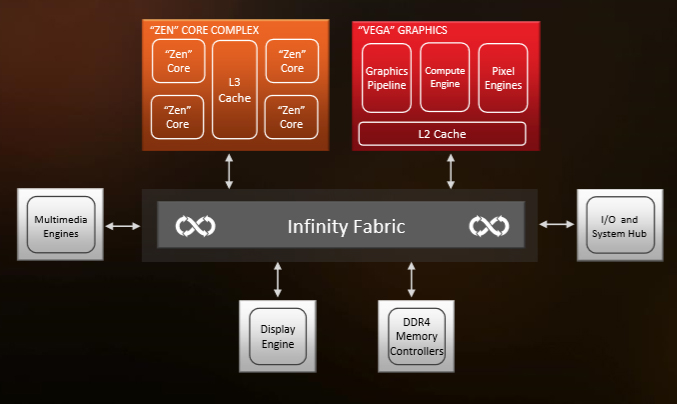
The Raven Ridge APU layout Highlighting the Infinity Fabric Interconnect
We have seen that the Infinity Fabric interconnect used within the SoC benefits from the use of faster memory in our Ryzen APU memory frequency scaling testing - because the Infinity Fabric and memory speed are directly linked, the CPU cores and GPU cores can communicate between the different areas faster. When overclocking a system for more performance, it all comes down to identifying the bottlenecks. Multiple bottlenecks can be in play at once, such as CPU frequency, GPU frequency, memory speed, and interconnect speed. As our set of articles on APU scaling have progressed, the final one left to analyze was GPU frequency. Hence, this review.
Scaling the APU, One Step (50 MHz) at a Time
For our overall analysis, we are splitting the data into two sets.
First up is the performance difference when simply overclocking the integrated graphics. Stepping up the frequency, as shown on the previous pages, usually increases performance, but here we will tell you how much in all four key areas: 2400G frames per second and percentile results, as well as 2200G frames per second and percentile results.
The second is to compare maximums. We have data now with the maximum tested integrated graphics frequency (1600 MHz) and the maximum tested CPU core frequency (3.9 GHz). The question becomes how much of a difference does overclocking one over the other make for gaming. The answer would normally sound obvious, but this is something we want to quantify. If a gamer has a choice between overclocking the CPU or the GPU, what should the target be, and how much should they expect? This data answers that question.
Group 1: 1600 MHz vs Stock
When comparing the results with the Ryzen 2000 series APUs at their stock settings against an overclock of 1600 MHz yields some good results across the majority of the titles tested in our testing suite.
Starting with the average frame rates, the Ryzen 3 2200G showed the biggest gains across the board, with the biggest benefits of overclocking in more graphically intensive games such as Total War: Warhammer 2 and Rise of the Tomb Raider. The 2400G, with its 28% overclock, pushed above 10% in Warhammer 2 and F1 2017, looks like it did not gain as much as the 2200G, but this is due to the lower percentage gain over the stock performance.
Focusing specifically on the 99th percentiles from the testing, the results given were erratic to say the least. All test results were repeatable across operating system reinstalls, but the 2400G showed regression in Shadow of Mordor and Warhammer 2. By contrast, the 2200G saw gains in both of those titles, a minimum of 8% across the board, and several titles scored around a 30% gain. For a 45% overclock, this is pretty good.
Group 2: What is Better, CPU OC or IGP OC?
In this set of results, we compare the uplift gained from a full GPU overclock to a full CPU overclock. This is to show which component of the chip provides the biggest benefit to frame rate performance in games: CPU or graphics. While increasing the CPU frequency is beneficial in improving performance in computationally dependent tasks such as video encoding, rendering and compression tasks, games should enjoy the graphics much more.
In our 2400G results, the winner between the two is clearly the integrated graphics. The CPU data shuffles around the same frame rates, not offering much benefit, while overclocking the GPU gives at least 5% extra frame rates across the board.
As the 2200G starts off from such a low point, overclocking both the CPU and GPU gets extra performance in almost every title. However, only overclocking the integrated graphics gets a good 10% gain across the board as a minimum, but more like 24%+ on games like F1 2017, Rise of the Tomb Raider, and Warhammer 2.
So while the analysis here is perhaps not as long-winded as our memory scaling and core frequency scaling pieces, the crux is that the integrated graphics is the key factor in gaming performance and despite the Infinity Fabric Interconnect combined with faster memory displaying a positive showing in our Ryzen 2000 series memory scaling analysis, the integrated graphics does offer more from a gamers standpoint. Of course, combining faster memory on top of an already overclocked Ryzen 2000 series iGPU is going to be the golden crown.
The Ryzen APUs; iGPU vs Core Frequency Plus Memory Frequency
When we took a look at how CPU Core Frequency Scaling with the Ryzen 5 2400G and Ryzen 3 2200G, we saw that the majority of the benefits came in compute heavy related tasks, and even gaining a distinct advantage when gaming with a discrete GPU. The gaming performance by just overclocking the CPU core frequency didn’t yield the results expected when using integrated graphics. In our dive into Memory Scaling on Zen and Vega, the consensus was that memory has a much greater effect on gaming performance than CPU frequency, as well as memory reliant applications and programs. Now while the focus has been purely on gaming this time around, which is to be expected given the target market AMD has aimed the Ryzen APUs firmly at, the results in some cases made a large difference in average frame rates; 99th percentiles on the whole did improve as the integrated graphics frequency went up, but some of the results were a little erratic, sometimes surpassing the overclock percentage jump.
For gaming, the extra performance gained in relation to the increase in graphics frequency is absolutely paramount in situations where average frame rate sits just below a key metric such as 720p60 or 1080p30. Gaming at 1080p60 is a little too much of a stretch for the integrated Vega cores, unless the game engine is less complex such as with titles such as MOBAs like DOTA 2, League of Legends and more recently, games like Fortnite being fine for this mixture of resolution and frame rate. As we found out in our Ryzen APU Overclocking Guide and Results article, the Ryzen APUs tend to prefer either high CPU frequencies or higher integrated graphics frequencies, but not both at the same time.
This means that users can choose which element of performance they want to improve, if the system is for compute related tasks or gaming. For any compute related workloads, the integrated graphics frequency is ineffective whereas pure MHz on the Ryzen cores and memory frequency can play a major part in improving performance throughput.
| Recommended Reading on AMD Ryzen APUs | |||
| 2400G Review | 2200G Review | Overclocking | Delidding |
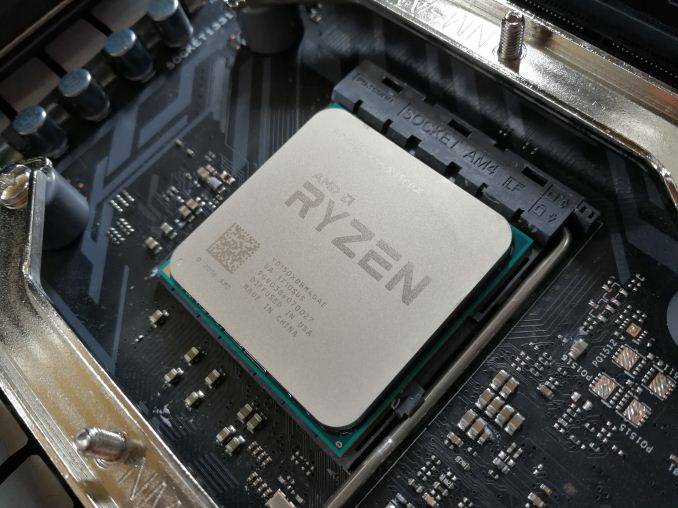 |
 |
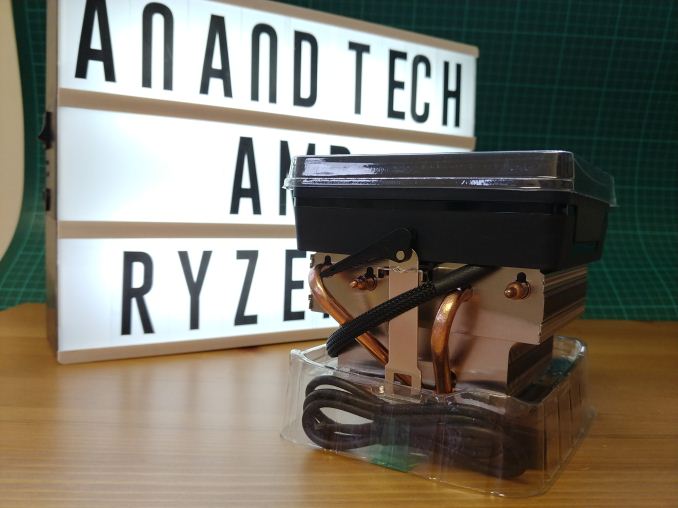 |
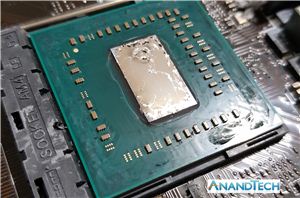 |
| Core Scaling | Memory Scaling | Graphics Scaling | Best CPUs |
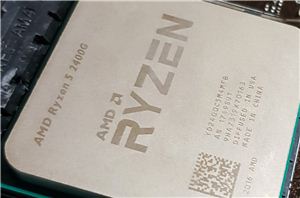 |
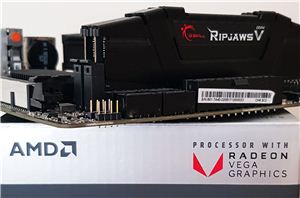 |
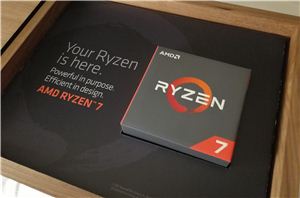 |
|


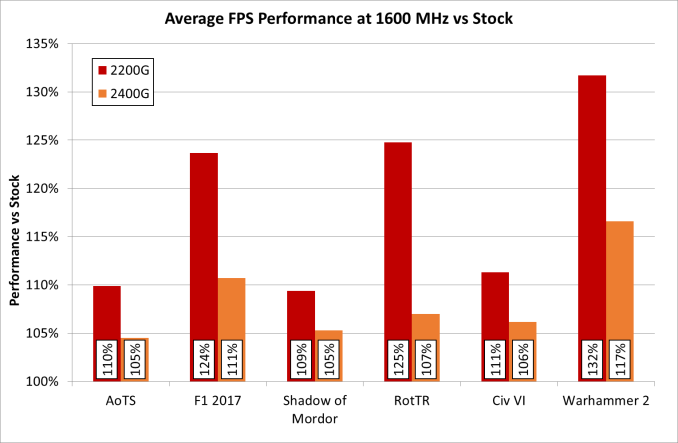
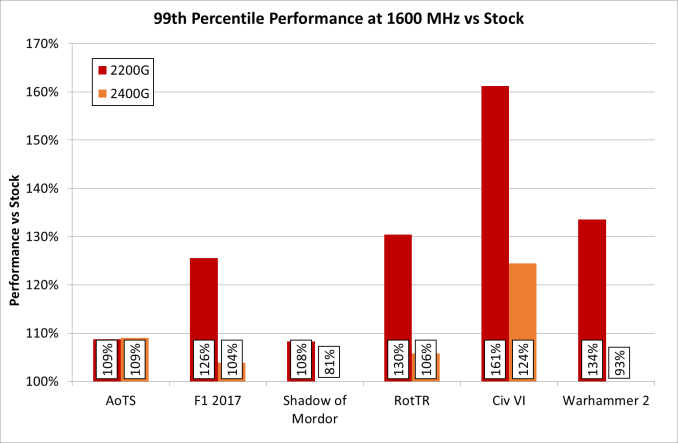
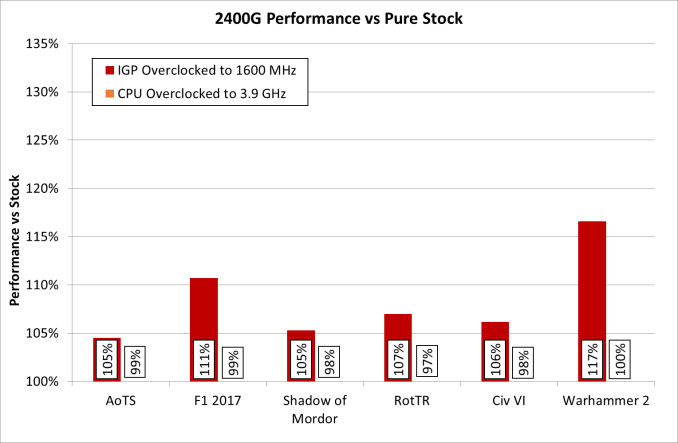
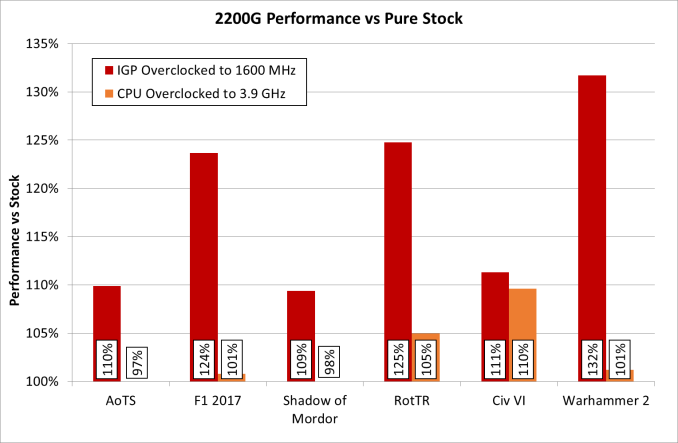
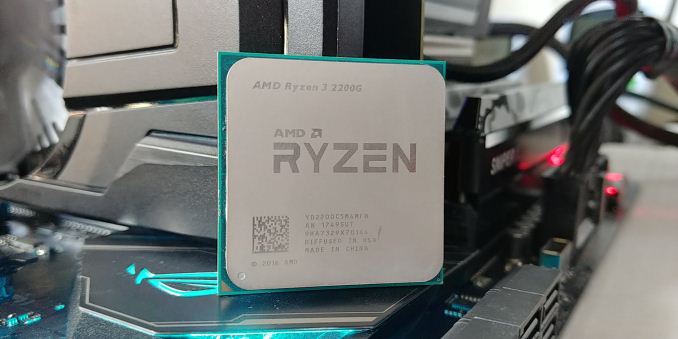








49 Comments
View All Comments
gavbon - Friday, September 28, 2018 - link
Yeah I do agree with you there, but the main purpose of an APU is to utilize the onboard graphics. Ok sure you lose bandwidth due to the limitation of PCIe lanes on them, but the specs have to be cut down somewhere and rather that than CPU or iGPU power.seamonkey79 - Friday, September 28, 2018 - link
By less than 1% in the vast majority of games. For PCIe 3.0/3.1, 8 lanes is still plenty for a card to the point where benchmarks are within the margin of error. That is until you start looking at SLI, on the level of (at least) GTX 1080 Ti or Titan V cards. At that point, you would be building a new system anyway because you'd need a board capable of handling 2 x16 slots, which you wouldn't have bought because a board with video outputs for the APU doesn't come with dual x16 slots. You're also buying a new CPU because you're not sticking $6k worth of hardware on a sub $200 CPU/chipset.https://www.gamersnexus.net/guides/2488-pci-e-3-x8...
https://www.gamersnexus.net/guides/3176-dual-titan...
In their testing, even on the Titan V, with a single card, there was no difference between x8 and x16.
So, no, you're not really in a situation where the APU will 'reduce performance', unless you're buying a sub-$200 CPU to stick in a system with around $6000 worth of dGPU. Which you can't do because you only have a single x8 slot anyway...
nathanddrews - Tuesday, October 2, 2018 - link
Correct, the only limitation is the 2200G/2400G itself (even at 4.1GHz), not the lanes. I've got a 1080Ti in my 3570K setup and I know full well when my CPU is the bottleneck.eva02langley - Saturday, September 29, 2018 - link
8x is performing basically the same for game performances. If you were to compute, that would be another story.It is actually a non-issue.
msroadkill612 - Wednesday, October 17, 2018 - link
Which is why its saddens me that the ~one true single ccx zen+ cpu - 2500x - is oem only.t.s - Friday, September 28, 2018 - link
Please fix: Civ. 6 graph are AVG FPS and AVG FPS, not AVG FPS and 99th %.Ryan Smith - Friday, September 28, 2018 - link
Whoops. Thanks for the heads up. Fixed!Valantar - Friday, September 28, 2018 - link
There are quite a few errors like this throughout the article. F1 for the 2200G are both 99th percentile. TW:W2 (same page) has the correct titles but same data in both images. There was more too, on earlier pages, but since I'm on my phone I can't look through it while writing this. Hope you can take a look.gavbon - Friday, September 28, 2018 - link
Thanks Valantar, fixed them now! Appreciate the heads up!ET - Friday, September 28, 2018 - link
My conclusion from this is that it's worth overclocking the 2200G to 1200 because the default clock performs badly in some cases.